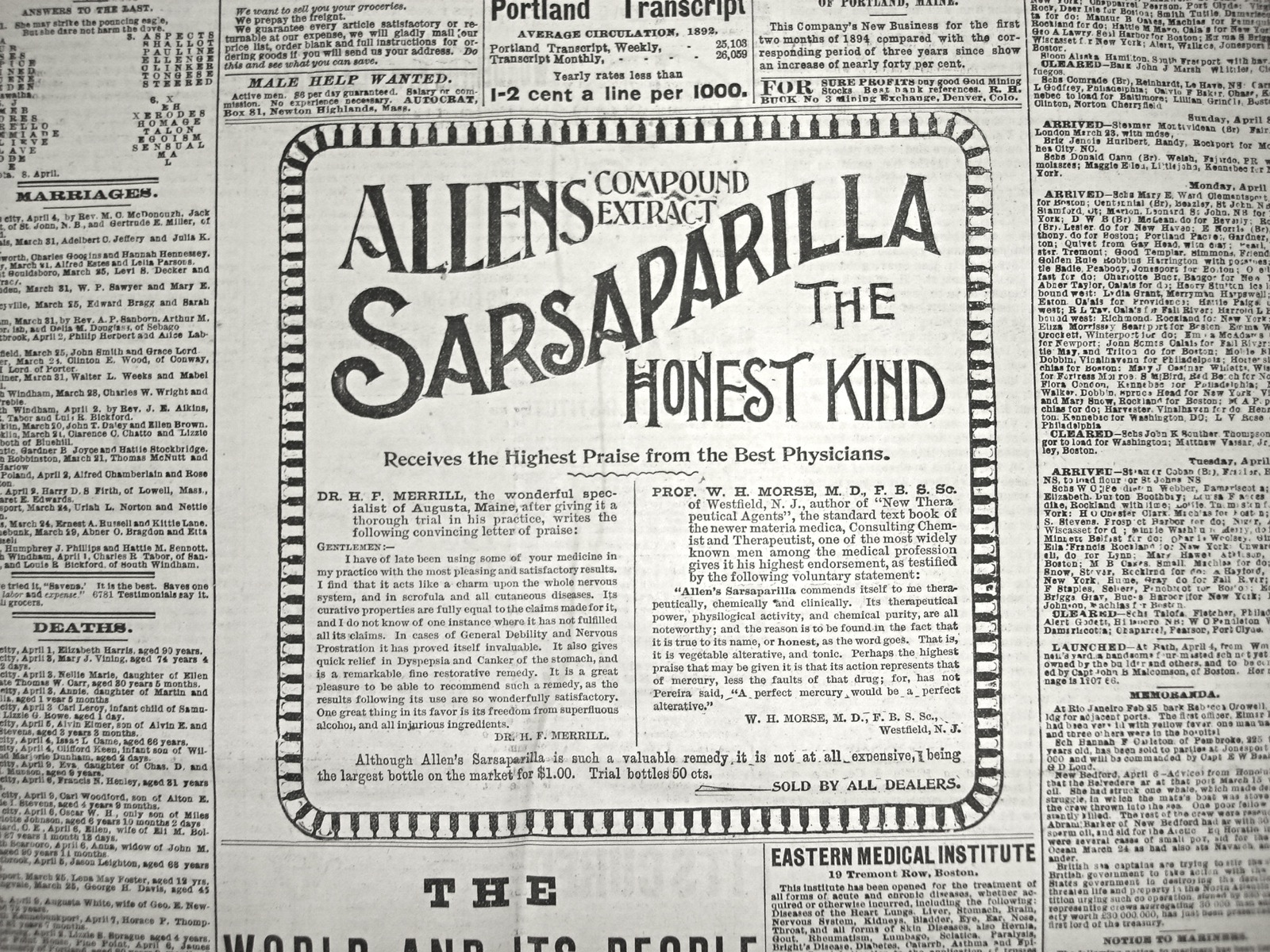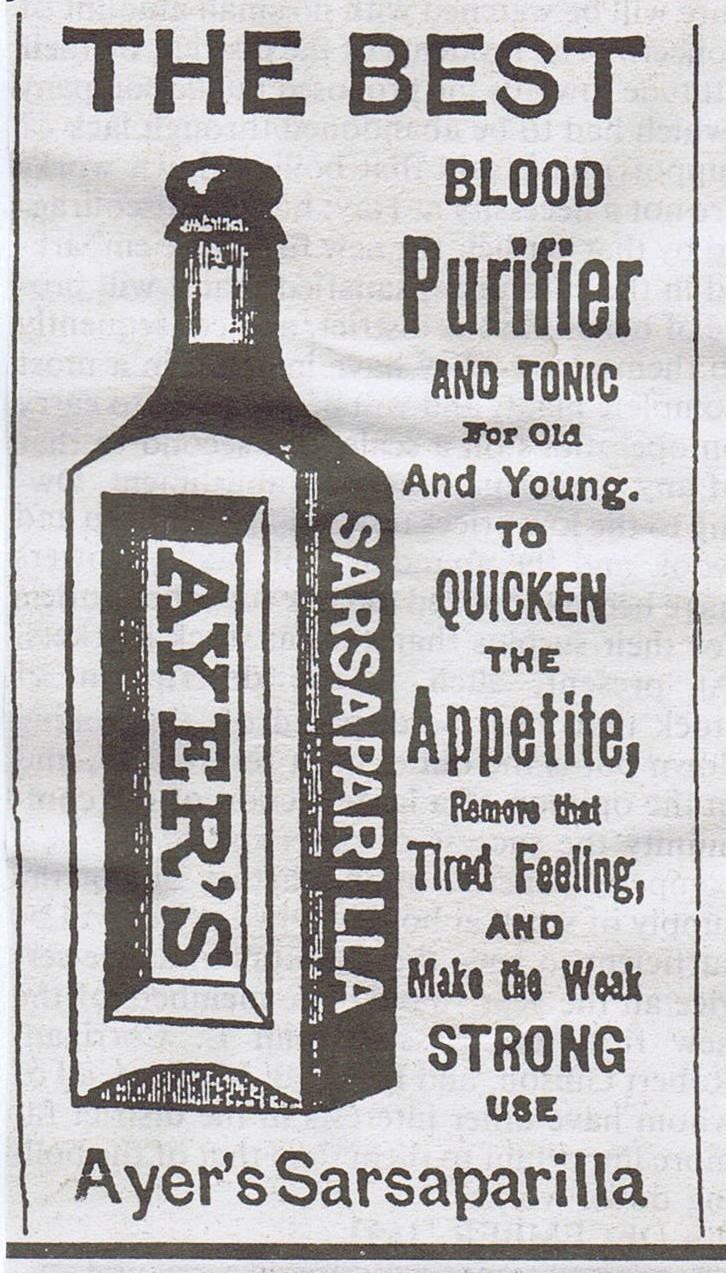Wild Sarsaparilla: From Native Medicine to the Medicine Show
Aralia nudicaulis - L.
[13]
Without studying plants to a certain degree, hiking through the woods must be like walking through a party where half of the attendees are invisible. In the anonymous streak of quivering greengage are hidden executioners, medics, poets, musicians and sweethearts. Aralia nudicaulis is a sweetheart, a medic, and one of those plants that may be easily overlooked. Their flower heads burst like googie starbursts beneath an umbrella of green leaves. Their aromatic rhizomes (their most celebrated attribute) creep secretly beneath the ground. Once you see them for who they are, they become a forest acquaintance with singular beauty, and one you wish to know better.
A member of the Ginseng Family, their purple berries and roots have been used in invigorating tonics, to heal wounds, and science has uncovered anti-cancer and antimicrobial properties that may be quite promising. And, hey, they are also sometimes used to flavor root beer. So welcome to the often overlooked, undervalued, and passed-over beauty of our native sarsaparilla: Aralia nudicaulis.
Description
The rootstock is fragrant, long, and chord-like. The flowering stalk emerges from the base of the plant from May to June and produces 12-30 tiny greenish blooms in three flower clusters. These produce round purple-to-black berries. The leafstalk is about 1 ft (30.5 cm) tall and divides into three. Each of the three 2-5 inch (5-13 cm) stems bears about five leaflets.
History
[6]
In the 1800's, over the counter medicine advertisements were saturated in almost comic bluster. If you were patient enough listen, they would yell out the complete list of human diseases covered in Gray's manuals from a bullhorn and tout their various tonics and elixirs as the sole cure. Sarsaparilla was no exception.
Sarsaparilla was a medicine of commerce in the 19th century (SEE IMAGE 6) replete with testimonials and claims of its power to cure essentially every known ailment on planet Earth. For instance, here is a woefully incomplete list of ailments that Hood's Sarsaparilla claimed to cure and actions the tonic claimed to have:
"...invigorating the whole system, in renovating and enriching the blood, in giving an appetite and tone to the stomach, in eradicating and curing scrofula, scrofulous humor, scaldhead, syphilitic affections, cancerous humor, ulcers, sores, tumors, ringworms, salt-rheum, boils, pimples and humors on the face, catarrh, headache, dizziness, faintness at the stomach, constipation, pains in the back, kidney complaint, female weakness, general debility, costiveness, biliousness, dyspepsia, indigestion, lassitude and languor peculiar" [8]...
Of course "female weakness" is not a real disorder and "scaldhead" is the perfect name for an embarrassingly terrible band your coworker is in; regardless of these facts, this incomplete list is already absurdly long.
Although from completely different families, two different plants named sarsaparilla were used to make the many brands of sarsaparilla elixirs discussed above: Aralia nudicaulis (the wild American plant) and various tropical South American Smilax spp. plants [10]. Since Aralia nudicaulis was especially abundant and well known, the South American sarsaparilla was touted as the "official article" by companies like Brisol's in order to champion their own wares. The following, particularly rancorous, excerpt was taken from an 1848 printed infomercial for Bristol's masquerading as a steamboat traveler's guide.
[9]
You can almost feel the manufactured disgust! How can those home-remedy makers be so stupid, right? Yet sometimes-- even in the most artless and depraved articles of quack medical advertising-- you can hear the canary heart of a caged artist gasping within a writer's chest. Listen...
"In tropical countries, alone, are found the pungent spices, and
aromatic shrubs, and precious gums, that are sought for by all
nations, and are consequently wafted on the wings of commerce,
throughout the globe. In vain does the most skilful culture essay
to grow, in colder climes, the various medicinal roots and plants,
which need the rays of the burning sun of the equator to concen-
trate their rare juices, and give them power and efficacy."
"Precious gums... wafted on the wings of commerce... rare juices:" this utter bullshit is peppered with lyrical magic. Nevertheless, the use of Aralia nudicaulis - L. persists, and perhaps for justifiable reasons in addition to the simple pursuit of a more intimate connection with the natural world. Sometimes a simple gesture showing "I love you and want you to feel good," in and of itself, may contain miraculous healing powers.
Habitat
Aralia nudicaulis - L. grows in moist forested areas with rich soil.
[12]
Culinary Uses
The root used as a root beer ingredient and for tea infusions. The berries and roots are used in various medicinal tonics (SEE Ethnobotany). The fruits were eaten by the native people of BRITISH COLUMBIA[5].
Ethnobotany
The OJIBWA macerated the fresh root into a poultice to treat boils and abscesses; "WHITE MEN" of Milwaukee in the 1930s used Sarsaparilla to induce sweating and as a general tonic to treat illness[1]. The MENOMINEE used the root root tea for lung troubles and sores [4]. Sarsaparilla was miscellaneously used as a cathartic and general health tonic in MONTANA [3]. The root was used by the MESKWAKI for internal troubles [5]. POTAWATOMI and OJIBWA used the roots as a cough remedy, to alleviate sore eyes, and as a poultice. For long journeys, the roots and berries were used to make an invigorating tonic by SASKATCHEWAN natives. The roots were mashed into a poultice to heal wounds by the HOCAK. The roots and fruits were used in a decoction/tonic form to treat colic, cough, and gripes by the CHOCKTAW.
The plant was considered to be a diaphoretic and alterative medicine often used to treat rheumatism, syphilis and other conditions presenting with lesions among people in the southern United States. During the Civil War, decoction of Aralia nudicaulis roots along with persimmon root bark was used to treat sexually transmitted diseases that presented with a nasty discharge of some sort.
[14]
Pharmaceutical effects
Aralia nudicaulis root extract was shown to have potential anticancer activity [11]. The rhizomes contain secondary metabolites that have antimicrobial action.
Nutrition
The berries were shown to contain 0.28% fat and 1.34% protein and 16.38% glucose-based carbohydrates.
Miscellaneous
The OJIBWA used the roots in nets to attract fish and repel rattlesnakes [5].
Pull Up Your Plants! (PUYP) is now receiving visits from all over the world. Please take the time to leave a comment or subscribe below. I’d like to hear about your experiences with Sarsaparilla.
For source citations, please email Kevin Healey at
pullupyourplants. @ gmail.com
With Love,
Kevin.


![[13]](https://images.squarespace-cdn.com/content/v1/59bae60f1f318d07a99856a4/1516337722466-GEJEI31H4JUA30HQBX5G/Sarsaparilla+Photo.jpg)

![[6]](https://images.squarespace-cdn.com/content/v1/59bae60f1f318d07a99856a4/1516209934784-X53Q1L6IAT4IVQOJVOFS/Sarsaparilla.jpg)




![[9]](https://images.squarespace-cdn.com/content/v1/59bae60f1f318d07a99856a4/1516244907432-8C626XTB8H6WFKLJRO8R/Screen+Shot+2018-01-17+at+8.05.40+PM.png)
![[12]](https://images.squarespace-cdn.com/content/v1/59bae60f1f318d07a99856a4/1516337795261-QSW5BWRO36SWR7ZZCTYE/Screen+Shot+2018-01-18+at+9.56.05+PM.png)

![[14]](https://images.squarespace-cdn.com/content/v1/59bae60f1f318d07a99856a4/1516338032177-A3VLESYUAH94JLA04952/Sarsaparilla+Photo2.jpg)

